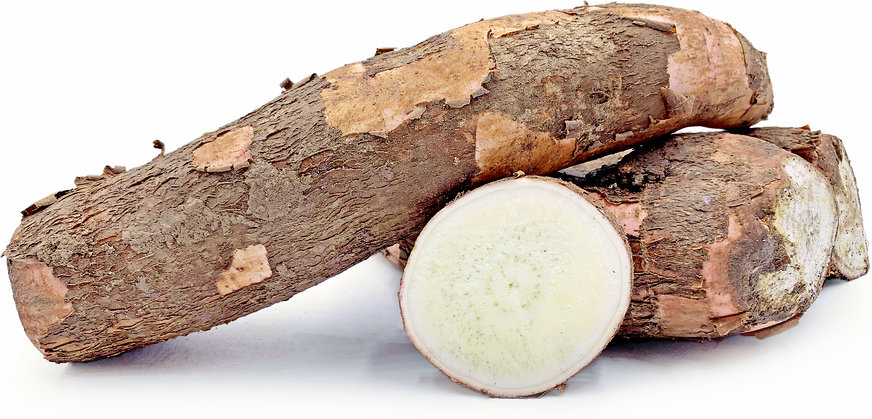


Yellow Yuca Root
Estimated Inventory, lb : 0
Description/Taste
Yellow Yuca roots vary in size, but in general, the roots average 15-30 centimeters in length and 5-10 centimeters in diameter and have an elongated, cylindrical shape with one tapered end. The rough skin ranges in color from light to dark brown and is fibrous, firm, and tough. Underneath the skin, the flesh is dense, starchy, and dry with a pale yellow to ivory hue. Yellow Yuca roots must be peeled and cooked prior to consumption and once cooked, the flesh develops into a soft, chewy consistency with a mild, nutty, and slightly sweet flavor.
Seasons/Availability
Yellow Yuca root is available year-round.
Current Facts
Yellow Yuca, botanically classified as Manihot esculenta, are edible, underground roots of a woody shrub that can reach up to four meters in height and belongs to the Euphorbiaceae or spurge family. Known by many names including Yellow Cassava, Manioc, Mandioca, and Aipim, Yellow Yuca grows in a wide variety of soils and is typically harvested 9-12 months after sowing. Yellow Yuca is a fairly new variety that was developed for its high vitamin A content and is one of the most popular crops in tropical regions across the world as a source of calories for rural communities. Yuca root should not be confused with yucca, which is an ornamental desert plant. The two plants are very different species, and though some descriptions and cultures use yucca interchangeably for both species, there is a distinction, and the edible root is most commonly spelled with one “c” as yuca.
Nutritional Value
Yellow Yuca is an excellent source of vitamin A, manganese, and starch, but is most well-known for its high carbohydrate content. The root also contains some phosphorus, iron, vitamin C, and calcium.
Applications
Yellow Yuca must be peeled and cooked prior to consumption as it is toxic and lethal when raw. The starchy root has a very mild flavor and is versatile with many different seasonings and herbs, making it suitable for a wide variety of cuisines. Yellow Yuca roots can be used similarly to potatoes and are well-suited for baking, mashing, steaming, grilling, boiling, and frying. The root is most popularly boiled and can be served as a side dish to cooked meats, sliced thinly and fried to make chips, or fried into a denser version of a French fry. It can also be tossed into soups and stews, or ground into a powder known as tapioca flour in the Western world for use in tamales, bread, muffins, pancakes, and empanadas. In the Caribbean, yuca root is grated, flattened, and fried with salt to make casaba, or unleavened flatbread, and it can be creamed and mashed to make a creamy, neutral side dish. The root is also used in Cuba to make yuca con mojo, which is cooked yuca covered in a sauce comprised of spices, garlic, onions, and citrus juice. In Brazil, Yellow Yuca is used in a popular snack known as manioc balls where the root is filled with cheese and fried. Yellow Yuca pairs well with fried fish, poultry, beef, and chorizo, cheeses such as gorgonzola, cheddar, and mozzarella, coconut, tomato, cilantro, parsley, scallions, onions, and garlic. Fresh Yellow Yuca root has a very short shelf life and will only keep for a couple of days when stored in a cool and dry place. The root can also be frozen for several months or dried and ground into a powder for extended use.
Ethnic/Cultural Info
Yuca is the third most important source of carbohydrates found in the tropics behind corn and rice. Labeled as a security crop, this root can grow in poor soils and is tolerant of drought. It also produces high yields and can be harvested at any time providing developing communities with sustenance year-round. White yuca was the most common variety of yuca grown in Africa, but Yellow Yuca has recently been introduced with the hope of providing a more well-balanced meal to locals. Yellow Yuca provides a nutritious source of vitamin A, which is necessary for overall health, and this vitamin is often lacking in the diets of developing countries. In Africa, yuca is most popularly dried, ground, and made into a dough-like paste to make fufu, which is served with soups and stews.
Geography/History
Yellow Yuca root is native to South America and was discovered in the Amazon. Once found, the root was further developed and studied at the International Center for Tropical Agriculture in Colombia and was then sent to the International Institute of Tropical Agriculture in Nigeria. In Africa, Yellow Yuca was bred for increased nutritional content for over twelve years before it was released to rural communities. Today Yellow Yuca can be found in tropical regions in Asia, Southeast Asia, Africa, the Caribbean, Central America, and South America and is also sometimes exported from Central America to the United States.
Recipe Ideas
Recipes that include Yellow Yuca Root. One




